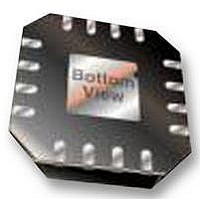AD8426ACPZ-R7 Analog Devices Inc, AD8426ACPZ-R7 Datasheet - Page 25

AD8426ACPZ-R7
Manufacturer Part Number
AD8426ACPZ-R7
Description
58T4523
Manufacturer
Analog Devices Inc
Specifications of AD8426ACPZ-R7
Rohs Compliant
YES
Lead Free Status / Rohs Status
Compliant
APPLICATIONS INFORMATION
PRECISION STRAIN GAGE
The low offset and high CMRR over frequency of the
make it an excellent candidate for bridge measurements. The
bridge can be connected directly to the inputs of the amplifier
(see Figure 68).
DIFFERENTIAL DRIVE
The differential output configuration of the
same excellent dc precision specifications as the single-ended
output configuration.
Differential Output Using Both AD8426 Amplifiers
The circuit configuration is shown in Figure 69. The differential
output specifications in Table 2, Table 4, Table 5, and Table 7
refer to this configuration only. The circuit includes an RC filter
that maintains the stability of the loop.
The differential output voltage is set by the following equation:
where:
The common-mode output voltage is set by the average of +IN2
and REF2. The transfer function is
350Ω
350Ω
V
V
G
DIFF_OUT
CM_OUT
=
+IN1
–IN1
1
+
R
G
= (V
49
350Ω
350Ω
= V
Figure 69. Differential Circuit Schematic
4 .
R
G
+
–
OUT+
OUT+
AD8426
k
Figure 68. Precision Strain Gage
Ω
− V
+ V
OUT−
OUT−
10µF
AD8426
REF2
)/2 = (V
= G × (V
–
+
0.1µF
+IN2
R
G
IN+
10kΩ
+IN
–IN
100pF
+ V
− V
5V
AD8426
+
–
AD8426
REF2
IN−
+INx
V
V
)
)/2
OUT+
OUT–
2.5V
has the
AD8426
Rev. 0 | Page 25 of 28
A common application sets the common-mode output voltage
to the midscale of a differential ADC. In this case, the ADC
reference voltage is sent to the +IN2 terminal, and ground is
connected to the REF2 terminal. This produces a common-
mode output voltage of half the ADC reference voltage.
2-Channel Differential Output Using a Dual Op Amp
Another differential output topology is shown in Figure 70.
Instead of a second in-amp, one-half of a dual op amp creates
the inverted output. The recommended dual op amps (the
AD8642
configuration allows the creation of a dual-channel, precision
differential output in-amp with little board area.
Figure 70 shows how to configure the
output.
The differential output voltage is set by the following equation:
where:
The common-mode output voltage is set by the following
equation:
The advantage of this circuit is that the dc differential accuracy
depends on the
This circuit takes advantage of the precise control of the
over its output voltage relative to the reference voltage. Op amp
dc performance and resistor matching do affect the dc common-
mode output accuracy. However, because common-mode errors
are likely to be rejected by the next device in the signal chain, these
errors typically have little effect on overall system accuracy.
For best ac performance, an op amp with gain bandwidth of at
least 2 MHz and a slew rate of at least 1 V/μs is recommended.
Good choices for op amps are the
V
V
G
DIFF_OUT
CM_OUT
=
and the AD822) are packaged in an MSOP. This
1
+IN
–IN
RECOMMENDED OP AMPS: AD8642, AD822.
RECOMMENDED R VALUES: 5kΩ TO 20kΩ.
+
Figure 70. Differential Output Using an Op Amp
= (V
49
= V
R
4 .
AD8426
AD8426
G
REF
OUT+
OUT+
k
Ω
− V
− V
and not on the op amp or the resistors.
OUT−
OUT−
R
R
)/2 = V
= G × (V
AD8642
–
OP AMP
BIAS
AD8426
IN+
V
− V
BIAS
+
and the AD822.
IN−
for differential
V
V
)
OUT+
OUT–
AD8426
AD8426











